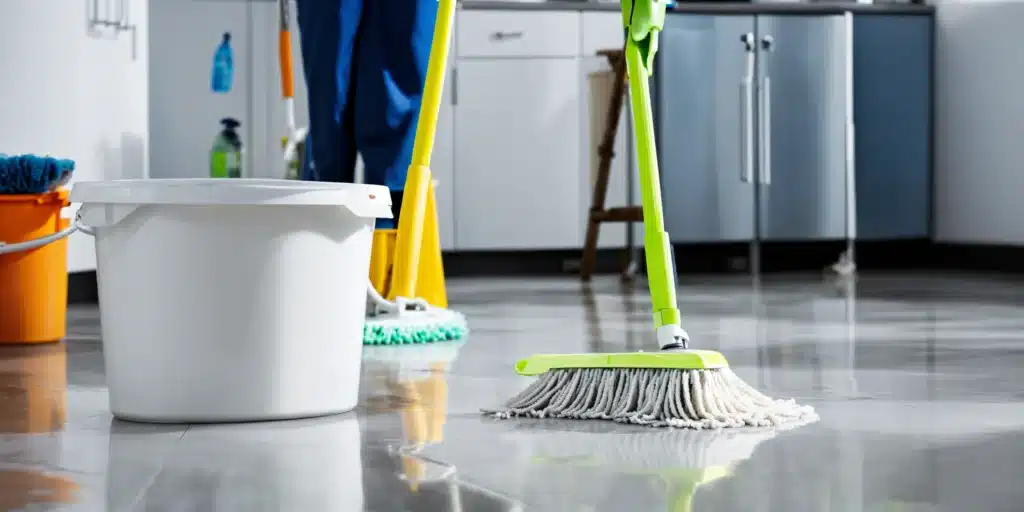Let’s be honest—there are few things more frustrating than walking across your kitchen or bathroom and feeling your shoes (or worse, your bare feet) sticking to the floor. Whether it’s from spilled soda, cooking grease, or a mysterious substance that appeared overnight (thank you, kids and pets), knowing how to clean sticky floor surfaces is essential for maintaining a fresh and inviting home.
Understanding the Sticky Situation
Before you dive in with a mop and bucket, take a moment to figure out the culprit. Different substances require different approaches, and using the wrong method can make the mess worse. Here are some common causes of sticky floors:
- Food and Drink Spills – Sugary substances like juice and soda create a sticky residue.
- Cleaning Product Build-Up – Excess cleaner left behind can turn into a sticky film.
- Grease and Oil – Kitchen floors often suffer from grease splatters.
- Humidity and Moisture – High humidity can make certain cleaning products feel tacky.
- Wax and Polish Overload – Too much floor polish can create an unpleasant, sticky layer.
Now that we know what we’re dealing with, let’s get down to business.
Step-by-Step Guide: How to Clean Sticky Floor Surfaces
1. Start with a Dry Sweep or Vacuum
Before you introduce any liquid, clear away loose debris. Use a broom, dust mop, or vacuum to remove crumbs, dirt, and dust. This will prevent you from spreading grime while mopping.
2. Choose the Right Cleaning Solution
Different sticky messes require different solutions. Here’s what works best:
- For Sugary Spills: Mix warm water with a few drops of dish soap.
- For Greasy Residue: A solution of hot water and white vinegar does wonders.
- For Cleaner Build-Up: A mix of warm water and a splash of ammonia can cut through the residue.
- For Wax and Polish Buildup: A specialized floor stripper or diluted rubbing alcohol works best.
3. Mop with the Right Technique
- Use a microfiber mop or sponge mop for the best results.
- Dip the mop in your chosen solution, wring it out, and work in small sections.
- Don’t drown the floor—excess moisture can make things worse.
- Rinse the mop frequently to avoid spreading sticky residue.
4. Tackle Stubborn Spots with a Scrub
For those areas that refuse to budge, apply a bit of baking soda to a damp cloth or scrub brush and gently work the sticky area in circular motions. Rinse with clean water.
5. Final Rinse and Dry
Once you’ve scrubbed and mopped, it’s time for a final rinse. Use clean water and a mop to remove any leftover cleaning residue. Then, dry the floor with a clean towel or allow it to air dry to prevent water spots.
Tips to Prevent Sticky Floors in the Future
Cleaning sticky floors is one thing, but preventing them in the first place? That’s the real win. Here’s how:
- Wipe spills immediately – The longer a spill sits, the harder it is to remove.
- Use the right amount of cleaner – More doesn’t always mean better; excess cleaner can leave a film.
- Rinse your mop often – A dirty mop just spreads the problem around.
- Sweep daily – Regular sweeping reduces grime build-up.
- Place mats at entryways – This helps catch dirt before it reaches your floors.
The Bottom Line: A Clean Floor
Sticky floors might be annoying, but with the right techniques, they’re easy to conquer. Whether you’re dealing with kitchen spills, bathroom grime, or an entire house that seems to be sticking to itself, a proper cleaning routine will have your floors fresh and residue-free in no time.
And if keeping up with household cleaning feels overwhelming, why not call in the experts? Consider professional cleaning services in Denver to help maintain spotless floors and a sparkling home. Because let’s be real—sometimes, you just deserve a break!


